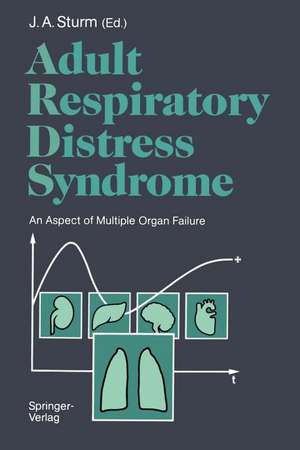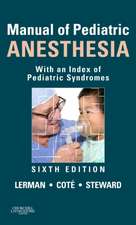Adult Respiratory Distress Syndrome: An Aspect of Multiple Organ Failure Results of a Prospective Clinical Study
Editat de J. A. Sturmen Limba Engleză Paperback – 7 mai 1991
Preț: 719.19 lei
Preț vechi: 757.04 lei
-5% Nou
Puncte Express: 1079
Preț estimativ în valută:
137.63€ • 149.45$ • 115.61£
137.63€ • 149.45$ • 115.61£
Carte tipărită la comandă
Livrare economică 22 aprilie-06 mai
Preluare comenzi: 021 569.72.76
Specificații
ISBN-13: 9783540521808
ISBN-10: 3540521801
Pagini: 360
Ilustrații: IX, 347 p. 8 illus.
Dimensiuni: 155 x 235 x 19 mm
Greutate: 0.5 kg
Editura: Springer Berlin, Heidelberg
Colecția Springer
Locul publicării:Berlin, Heidelberg, Germany
ISBN-10: 3540521801
Pagini: 360
Ilustrații: IX, 347 p. 8 illus.
Dimensiuni: 155 x 235 x 19 mm
Greutate: 0.5 kg
Editura: Springer Berlin, Heidelberg
Colecția Springer
Locul publicării:Berlin, Heidelberg, Germany
Public țintă
ResearchCuprins
I Clinical Aspects.- Study Protocol.- Extravascular Lung Water: Clinical Methodology.- Bronchoalveolar Lavage.- Morphometric Description of the Study Population.- Development of a Linear Scoring System.- Clinical Definition of ARDS An Index Based on Bedside-Derived Parameters.- Treatment and Clinical Course.- Progressive Organ Failure.- II Activation of Humeral Cascade Systems.- Adult Respiratory Distress Syndrome and Complement: Significance of C3a in Diagnosis and Prognosis.- Differences in Activation of Coagulation and Fibrinolysis After Polytrauma with Respect to the Development of Adult Respiratory Distress Syndrome.- III Activation of Cellular Systems.- Nonspecific Immune System, Plasma Proteins and Characteristics of the Erythrocyte Insulin Receptor.- Morphological and Functional Changes of Alveolar Cells.- Functional Changes in Polymorphonuclear Leukocyte Function Following Severe Polytraumatization.- Changes in Reticuloendothelial Capacity Associated with Liver Dysfunction in Multiple Trauma.- CD3 +, CD4+, CD8+ and B Lymphocyte Numbers in Blood and Bronchoalveolar Lavage Fluid from Trauma Patients with and without ARDS.- IV Activation of Inflammatory Cells.- Role of Leukotrienes in the Pathophysiology of ARDS After Polytrauma.- Specific Proteins of Inflammatory Cells and ?1- Proteinase Inhibitor in Alveolar Epithelial Lining Fluid of Polytraumatized Patients: Do They Indicate Posttraumatic Lung Failure?.- V Endothelial and Epithelial Mechanisms of Injury.- Plasma and Bronchoalveolar Lavage Fluid Proteins as Markers of Increased Lung Permeability in ARDS as a Result of Multiple Trauma.- Lung Capillary Leak After Severe Trauma: A Prospective Clinical Study.- Alveolar Surfactant Function in Severely Injured Patients.- Adult Respiratory Distress Syndrome as aManifestation of a General Permeability Defect.- Early and Late Ultrastructural Changes in the Lungs of Patients Suffering from Severe Polytrauma.- VI Experimental Studies.- Simultaneous Measurement of Endothelial Cell Damage, Elastase Release, and Chemiluminescence Response During Interaction Between Polymorphonuclear Leukocytes and Endothelial Cells.- Influence of Short- and Long-Term Endotoxin Administration on the Phagocytic Functions of Polymorphonuclear Leukocytes and Reticuloendothelial System in a Sheep Model.- The Three-Compartment Model in Sheep: The Effect of Recurrent Endotoxemia on Endothelial and Epithelial Permeability in the Lung.- Bacterial Toxins and Terminal Complement Complex: Significance for Lung Microvascular Injury.








